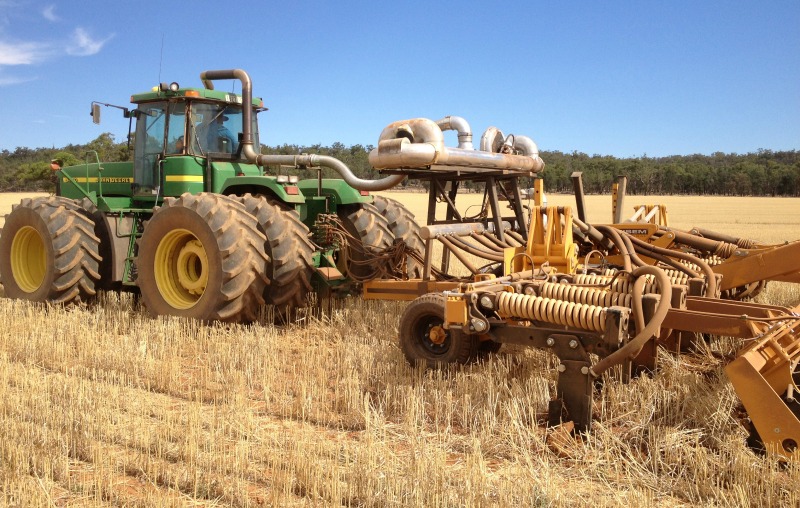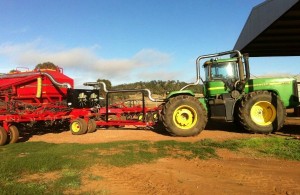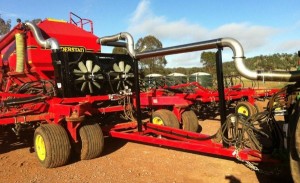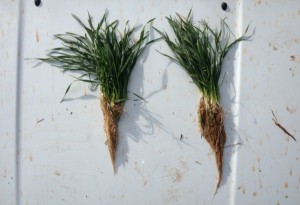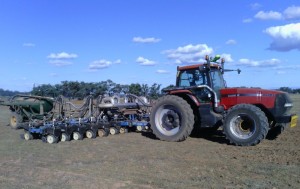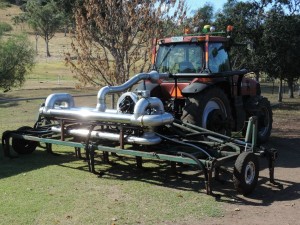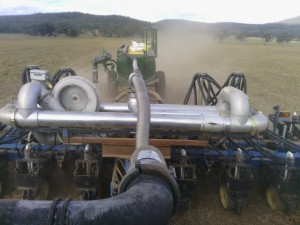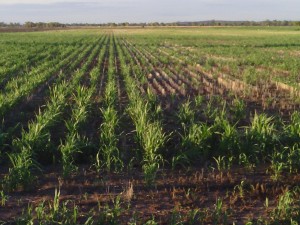I spoke with a couple of farmers this week who have been using the Bio-Agtive Emissions Exhaust system, to see how their crops are performing. I want to share this with you, but I also want to share a basic understanding of plant physiology in trying to help you understand how the Bio-Agtive exhaust system may be getting the results it is and how natural processes can support plant growth. Sometimes we forget to go right back to basics to understand things and I think it is helpful in this situation. Regardless if you are a cropper or a grazier or what you think of the exhaust system, there is some great understanding about plant growth here.
HOW DO PLANTS GROW?
Photosynthesis
I’m sure you will all recall the process of photosynthesis. Carbon dioxide is taken from the air by plants, and along with water from the soil and light energy from the sun, plants convert these things into plant photosynthates (sugars, starches, proteins, carbohydrates). Oxygen is released from the plant in this process. It can be simply represented by this equation.
6CO2+ 6H2O + sunlight energy = C6H12O6 + 6O2
(Carbon dioxide + water + sunlight = glucose + oxygen)
This is how carbon gets from the air into plants. The plant releases some of the produced sugars as root exudates to feed soil microbes and fungus (which supply nitrogen and other nutrients to the plant), as a result this is also one way that carbon ends up in the soil.
Respiration
Not only do plants photosynthesize and give off oxygen, they also do the opposite and respire to give off carbon dioxide. During respiration, sugars in the plant, produced by photosynthesis are combined with oxygen through oxidization and converted back into energy by the plant for growth and metabolism. Carbon dioxide and water are released in the process, as well as the energy.
C6H12O6 + 6O2= 6CO2 + 6H2O + energy
(Glucose + oxygen = carbon dioxide + water + energy)
Respiration is important for plants at night because the lack of sunlight energy means that energy for the plants must be produced in another way. Oxygen is used in the process, and when respiration occurs in the roots of plants, the carbon dioxide and the water that are given off as part of the process end up in the soil – around the root zone. This is why plants do not do well in waterlogged soils – as the roots cannot access the necessary oxygen for respiration. Similarly, soil microbes also respire. They take the root exudates/sugars of the plant, and combined with oxygen from the soil, create energy, carbon dioxide and water.
So, this has been a long way of demonstrating that plants not only take water from the soil to grow, but water can also be placed back into the soil by via root and microbe respiration. So, the greater root system and greater microbe and fungus populations present in the soil, the greater potential there is for respiration and for placing moisture back into the soil!
As I have explained in previous blogs, when we apply artificial fertiliser, this is a substitute energy and nutrient source for the plant. The plant does not need to give off sugars from its roots to feed microbes for their supply of nutrients to the plant – because the nutrients are already there in the fertiliser. The chemical formula for urea is (NH2)2CO. Do you notice anything about it? There is carbon, hydrogen and oxygen present – all things necessary to produce plant sugars from.
Calvin Lewis of Bio-Agtive Emissions Technology in Australia says that when artificial fertiliser is applied, the plant will get its energy source from the fertiliser instead. He says the need for photosynthesis (that usually provides carbon and oxygen for the production of plant photosynthates) is reduced as these nutrients and energy are partly provided by the fertiliser. If photosynthesis is reduced, root exudates are then reduced and soil microbes and fungus are not supported. Less soil biology means less soil respiration, and, as mentioned above, less moisture in the soil from this process. Calvin explains that when enough energy is supplied to the plant (in this case, via fertiliser), that the plant takes up negative chloride instead of positive potassium, to close its stomata to reduce photosynthesis because the plant already has readily available energy and nutrition.
So, Calvin explains that the Bio-Agtive Emissions system is stimulating and driving the natural processes of the plant.
Think about this in relation to the multispecies cover cropping blogs from a while back. Remember how much better the multi species crops handled the dry weather compared with the single species crops? Is this a reflection of varied plant species supporting a variation and mass of soil microbes, which are then respiring, moistening soil and helping to give plants resilience to drought?
So what do growers using the BioAgtive Exhaust system think about it?
NARRANDERA GROWER
Gavin Morris farms near Narrandera in NSW Australia. He is currently growing his third winter crop with the Bio-Agtive Emissions Technology. He farms in a 440mm (17.5inch) rainfall environment on mostly red loam soils. Gavin had the Bio-Agtive Exhaust System setup on his John Deere 9400 (400 horsepower) tractor and on his 18metre (60 foot) Seed Hawk planter with an on board seed bin and 12 inch row spacings.
When Gavin started with the system he went cold turkey on fertiliser. He had been spending $160,000 a year on crop fertiliser, and with the system setup (including a license) costing $60,000, he thought that he would have to be quite a way behind in yield before he was behind in dollars.
As it has panned out, Gavin reports comparable yields with his crops in the first two seasons, with crops looking good again so far this year. He grows wheat (or sometimes barley or oats), canola and lupins, in rotation, with a cereal every second year.
Ease at Sowing
Gavin is pleased by the ease of sowing as it is so much quicker when not handling and refilling with fertiliser, as well as not needing to deal with the logistics of getting fertiliser to the paddock. Seed is not ‘pickled’ or treated with fungicides, which omits another step in the process of sowing and prevents the need to be handling those fungicides. Another advantage of not treating seed is that if there is leftover seed after sowing, it is still readily saleable, as it is untreated and just clean graded seed.
No fungicides
Gavin likes the fact that the need to treat seed is removed, as he knows of the negative effect that fungicides can have on germination and emergence of seeds. As mentioned a couple of weeks ago in my initial blog on this system, the formaldehyde in the exhaust gases act as a fumigant on the seed.
No fertilisers
Gavin’s $160,000 per year fertiliser bill consisted of 100kg/ha of MAP (mono ammonium phosphate) at sowing or 60kg MAP at sowing with a top up of urea. There was also some gypsum and lime used as a soil amender. His fertiliser bill is now zero.
Gavin decided to give the system a go when he and his son Brad discussed that the system cost $60,000 up front for the unit and license, so they would save $100,000 on fertiliser in their first year. There would have to be quite a drop in crop yield before they would be worse off. The second year they are $160,000 ahead in saved costs (cumulative $260,000). This year they are another $160,000 better off with regard to costs (or $420,000). With Gavin reporting equivalent yields to traditionally fertilised crops with his first two crops, then he is a fair way in front.
This past autumn they have also purchased a deep ripper which is now set up to fit to the exhaust system from the tractor (which you will see in the photo at the header of this blog).
Testament to the profitability success of the exhaust system for Gavin are recent improvements in their farm business that have been afforded; new permanent silos, complete upgrade and re-gravel of their farm driveway and the acquisition of a new property. Gavin also farms with his son Brad, who has been able to acquire his own piece of farming country in the last year.
Soil Changes
I asked Gavin if there had been any noticeable soil changes. He reported that soils were possibly slightly more friable and open, but it was really too early to say. Soil tests have revealed that P levels are not going down, but have rather increased marginally.
It is a common observation among those using the system that crops bounce out of the ground – with earlier emergence than under a traditional system. After this however, through to around late tillering, the crops can look pretty unimpressive compared to traditionally fertilised crops. Biomass is much less and as a result crops can visually appear as though there is less yield potential. Calvin says that during this time, with BioAgtive exhaust treated crops, much of the activity is happening below the ground with root systems developing well (plants on right).
Even conventional agriculture knows that high upfront fertilisation of crops can lead to high leaf biomass, which can lead to a large ‘potential’ crop, but end in the crop not finishing well. This is partly why more strategic applications of nitrogen throughout the crop have been encouraged in recent years.
What else for Gavin?
In order to create a green bridge for soil microbiology, Gavin planted a cover crop of sorghum forage last summer – a crop not generally grown dryland so far south at Narrandera. This crop acted as a cover crop and supported soil microbiology with living roots, during a time that land would otherwise be fallowed.
Calvin explained to me that there was some success being seen from increasing sowing rates of crops. While this means slightly higher seed costs, it also means a greater number of root systems respiring. Despite double planting rates of 120kg/ha (versus 60 or 70kg/ha), crops are still holding on well in this dry season, looking no worse off for the dry than the lower planting rates, but with higher yield potential.
WERRIS CREEK GROWER
Another farmer that has set up his planter and other equipment with the Bio-Agtive Emissions Technology is Warwick Moore from Werris Creek, near where I live on the Liverpool Plains of NSW.
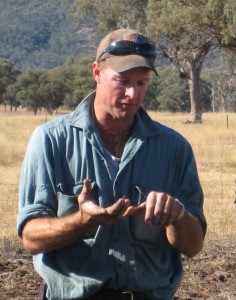
Warwick has put the Bio-Agtive exhaust system on his Case International MX 285 tractor (285 hp). This connects to his Kinze planters, a 15 tyned ripper or a set of offset discs.
Warwick is currently growing his 3rd crop with the system; last year’s and this year’s winter crop as well as a sorghum crop last summer. Warwick has also recently planted a Lucerne stand and is just beginning planting his 2nd summer crop. Warwick says the top end yield potential of the system hasn’t been tested on his property yet, as the last few years have been unusually dry, but he reports average crop yields for the area in each given year. Even if there was a slight yield disadvantage in the really big yield years, Warwick says he is happy to forgo this for the advantages to gross margin in other years.
Like other growers experience, Warwick says that he was a little frustrated early season with crops looking less than impressive, but in the last few weeks, the crops are looking great, while others around are starting to feel the pinch from dry weather. Canola which Warwick was advised to spray out early season is now looking like it has great potential.
$55,000 was the set up cost for Warwick, which he will have worked out by the end of this season (second winter crop), given his fertiliser savings.
A previous fertiliser programme would be 40-50kg/ha of a starter fertiliser (N,P,S, Zn) as well as 60-80kg/ha of anhydrous ammonia on winter crops. Summer crop would be 80-100kg/ha of anhydrous ammonia.
Warwick undertook a replicated trial in the first year of the technology’s use. The crop was wheat that was double cropped into sorghum country. There were three treatments:
- EO – Emissions only
- E+F – Emissions plus 50kg/ha nitrogen
- FO – Fertiliser only – 80kg/ha nitrogen
The results were as follows:
Yield
- EO 3t/ha
- E+F 2.4t/ha
- FO 3t/ha
Screenings
- EO 2.9%
- E+F 7.1%
- FO 7.2%
Test weight
- EO 80 kg/hl
- E+F 76 kg/hl
- FO 75 kg/hl
Protein
- EO 11.7%
- E+F 14.5%
- FO 15%
Moisture
- EO 10.9%
- E+F 11.8%
- FO 13.6%
Warwick is pleased with these results, especially the screenings. He is not concerned by the protein differences, explaining that he felt much of the high protein would be present in the pinched up screenings grain. With that being Warwick’s first season with the system, he has been learning since (and still) and tweaking his operations accordingly.
Tweaking the System
Warwick has been learning as he goes and is changing things accordingly as he learns. He has noticed that the crops may be slightly better in headland areas, so next sowing he thinks he will lower his planting speed. This would mean planting at around 9.5km/hr (versus 11km/hr previously), which will increase the rate of exhaust per hectare. Perhaps this is also a result of higher sowing rates on the headlands.
Warwick has also lifted his sowing rates slightly – with this year’s barley being increased from 55kg/ha to 65kg/ha. He has also done one pass of a double sown area where the sowing rate is around 130kg/ha. At this point in the season (with the barley out in head) Warwick reports it looks just as fresh as the lower rate sown areas, but with a greater yield potential.
Initially there were some operational learnings, like any new system. There is a cooler fan that is adjusted to manage the temperature of the exhaust gases, and its speed requires adjusting throughout the day, to prevent condensing of the gases in the seed box when approaching the cool of the evening. Warwick now knows how to manage such things.
In the picture below you can see a crop difference line. It is a forage sorghum crop (double cropped into wheat stubble) and both sides of the photo were planted with just emissions. The difference is in the wheat crop before it. The left side was treated with emissions only, while the right side was treated with emissions and urea.
Warwick is also currently setting up his irrigation pump, so that the exhaust gases are pumped into his irrigation water.
What is on the horizon?
As well as growers learning about the system, the manufacturers of the system are still learning too.
They have learned that different tractor engines give off different emissions and engines can be adjusted according to the soil type they are operated on.
Calvin explained that the soot in the exhaust gases is a fantastic carbon source – essentially raising the CEC of the soil. This output of black soot might be expected from an older engine and would be great on a sandy soil. Newer engines however, with environmental additions that recirculate gases so that any unburnt hydrocarbons are completely combusted, produce a gas that is highly oxidised. Microbes can only feed on oxidised material, and Calvin explained that gases from a newer engine like this would be great on a high clay soil (like in my area), which already has a very high CEC, but may be lacking microbial life. There are adjustments that can be made to engine operation to steer the gas output in one of these directions.
Also varying exhaust output is the fuel type. Biodiesels will burn with no soot but will burn more minerals than diesel – thus feeding biology more than adding carbon via soot.
The latest thing being examined by Bio-Agtive is adding extra additives to the exhaust gases via the fuel or after the engine in the exhaust, in order to speed up the stimulation of soil microbes and the mineral supply to the crops.
I was also curious as to whether there was any merit for this system under the Carbon Farming Initiative, but despite the submission of several methodologies, they have all been rejected by the relevant Australian Government Department at this stage.
Neighbours or farmers living close by to those already owning units is where the market in the exhaust systems seems to be growing, which tells me something about its success. There are currently around 34 farms using the Bio-Agtive Emissions Technology in Australia.
What do you think about the idea?

